Several materials are used to make magnetic jewelry, the majority of which are metals. In this guide, we will be talking about these different materials and the pros and cons each material offer when it comes to jewelry making.
The main ones we will be discussing are:
- Stainless steel
- Titanium
- Solid copper
- Ceramic
- Tungsten
- Wood
- Leather
Let’s jump right into it!
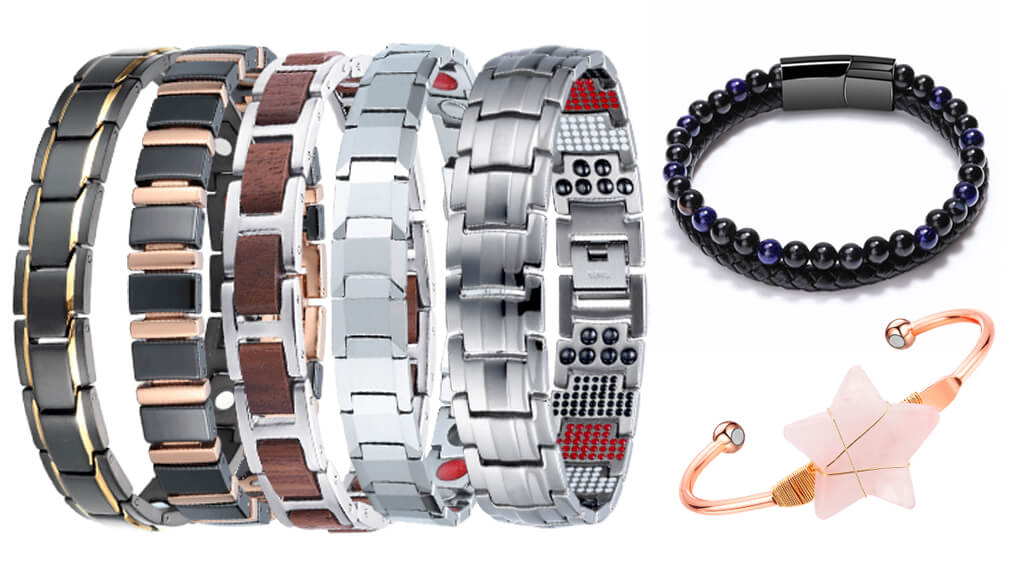
Stainless Steel
Stainless steel, a metal alloy, is made up of elements such as chromium and iron. It is durable and non-corrosive, meaning it won’t fade. It is used in the making of kitchen utensils, surfaces, and many pieces of jewelry.
In general, when talking about jewelry, there are four types of stainless steel used. They are:
- 304 stainless steel
- 316 stainless steel
- 316L stainless steel
The two common ones used for jewelry are grade 316L and grade 304.
You also can check this Post Stainless Steel Jewelry Guide for more details about stainless steel.
The table below shows the difference between their ingredients
| Max% | 304 | 316 | 316L |
| Fe | balance | balance | balance |
| Cr | 18-20 | 16-18 | 16-18 |
| Ni | 8.0-10.5 | 10.0-14.0 | 10.0-14.0 |
| Mo | – | 2-3 | 2-3 |
| Mn | 2.00 | 2.00 | 2.00 |
| Si | 0.75 | 0.75 | 0.75 |
| N | 0.10 | 0.10 | 0.10 |
| P | 0.045 | 0.045 | 0.045 |
| C | Max. 0.08 | Max. 0.08 | Max. 0.03 |

Pros of Stainless steel
| Hypoallergenic | Unlike gold and silver, you don’t have to worry about stainless steel jewelry triggering a flare-up, as it contains no impurities. |
| Easy to maintain | There is no hassle involved in the maintenance process. You simply need dishwasher detergent, warm water, and a soft cloth, and you’re good to go. |
| Variety of designs | There are many different shapes and patterns of Stainless steel jewelry from which you can choose. |
| Environmentally Friendly | Who doesn’t love the environment? I know I do. Jewelry manufacturers save on non-renewable sources by avoiding the use of too much primary energy. |
Titanium
Titanium, represented by “Ti”, is a lightweight but very strong metal. It is durable and non-corrosive. In addition, titanium does not lose its sheen like platinum or gold. Because of this fact, it is commonly used in jewelry.
Titanium is known for its hypoallergenic nature concerning the human skin. So, there is no need to worry about your hand, ear, ring, or any other part of your body having an allergy reaction. For titanium jewelry, an alloy is typically used instead of commercially pure titanium. BMJ manufacture all titanium jewelry with TA2 (Commercially Pure Grade 2 titanium).
You also can check this Post Titanium Jewelry Guide 2022 for more details.
Below table shows the BMJ Titanium and Titanium grade 2 Component Requirement ( standard of GB/T3620.1—2007).
| Component | (Grade 2 Require) Wt. | BMJ Jewelry Wt. |
| C | <0.1% | 0.005% |
| Fe | <0.3% | 0.05% |
| H | <0.015% | 0.009% |
| N | <0.03% | 0.004% |
| O | <0.25% | 0.19% |
| Ti | Balance | Balance |
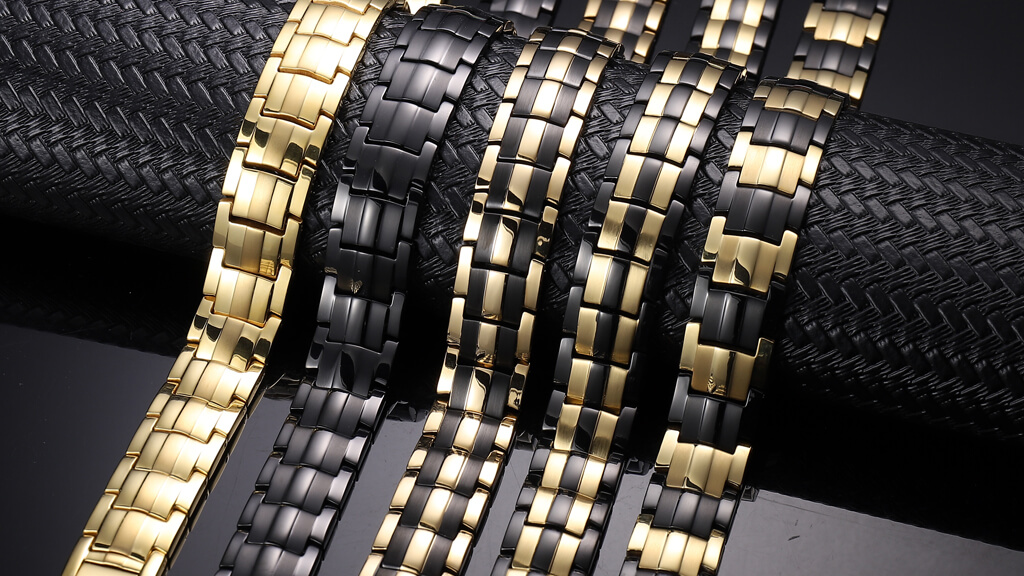
Titanium Pros
| Durable | When you purchase a piece of titanium jewelry, best believe that it will last you a lifetime. It has the best strength-to-weight ratio compared to other metals. |
| Hypoallergenic | Unlike gold and silver, you don’t have to worry about titanium jewelry triggering a flare-up or causing contact dermatitis. |
| Lightweight | Titanium is not only strong, but it is lightweight. You might even forget that you’re wearing it! |
| Variety of colors: | Unlike gold and silver, you can practically get a piece of titanium jewelry in any color of your liking. |
| Cost-effective | Compared to all the other traditional metals, titanium is much more cost-effective in the long run. |
Solid Copper
Copper, represented by the atomic number 29 and symbol ‘Cu’, is one of the most popular metals in the world. Copper is found naturally in the earth and typically sports a red-brown color. It is a good conductor of heat and electricity and plays a crucial role in the day-to-day activities ranging from air conditioning, and cookware, to automotive parts and power utilities.
Copper is not necessarily the strongest of materials, but it is not an understatement to say that it is very tough and malleable. It is exactly because of these properties that copper has been widely used in jewelry making for generations.
You can check this Post Copper Jewelry Overview 2022 for more details
Pros of Copper
| Anti-aging Properties | Copper contains antioxidants that help to fight aging radicals. It also helps to produce collagen, which aids in the antiaging process. |
| Relieves stiffness and joint pain. | The metal triggers the healing properties within the body to relieve pain. It is good for swelling and general body pain. |
| Good for Cardiovascular health | When you wear copper jewelry, properties are absorbed into the body’s circulatory system helping it to remove toxins and produce hemoglobin. |
| Versatility | Copper is very malleable. You can mold, bend and form copper easily so there is a variety of styles and designs. |
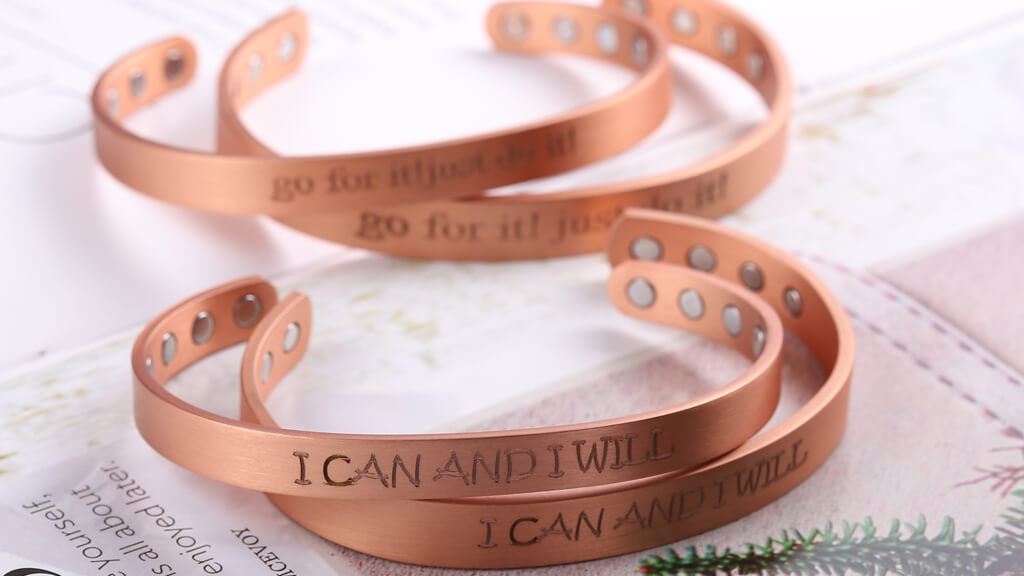
Ceramic
Ceramic is a substance that is neither organic nor metallic. It is a material created from human resourcefulness and ingenuity as they used materials such as mud, clay, water, sand, and fire to create a crystalline material, namely ceramic. It is usually chemically unreactive and hard.
Since ceramic is a flexible material and can be molded into different shapes, it is widely used in architecture, electronics, medicine, and even in jewelry making. It is traditionally used to make bricks, pottery, glass, tiles, jewelry, and cement.
Ceramic Jewelry Pros and Cons
| Pros | Cons |
| Affordability: Ceramic is relatively affordable compared to other materials. | Resize issues: Ceramic jewelry is not capable of resizing. So, once it is made, that will be the final size. So, you must get the correct size from the start. |
| Durability: Ceramic is a hard material and will not scratch easily.while it will be break if fall off. It is less brittle compared to tungsten. | Limited Designs: Due to its inflexible and rigid nature, ceramic is not easy to work with. It is hard to make intricate designs or add gems to them. |
| Hypoallergenic: 100% hypo allergic and will not trigger a flare-up or causing contact dermatitis. | Hardness: Due to how hard and brittle the material is, it is prone to break and chip. |
| Easy to maintain: There is no hassle involved in the maintenance process. You simply need a damp cloth and warm water, and you’re good to go. | Color limited: black and white are normal and easy to product. Other color available: pink, blue, coffee |
| Variety of colors: You can practically get a piece of ceramic jewelry in any color of your liking.And color will never fade. |
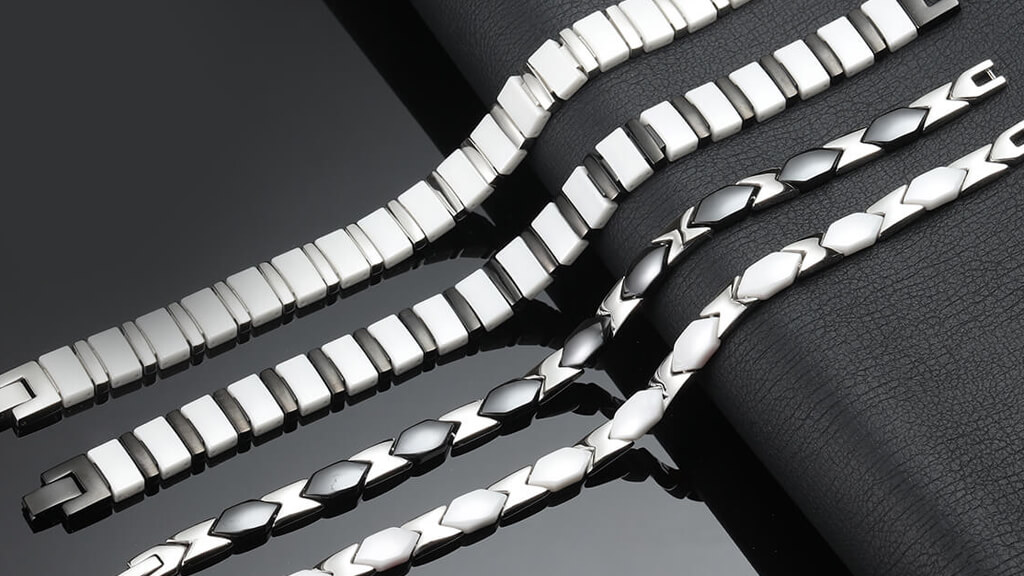
Tungsten
Tungsten, represented by the atomic number 74 and symbol ‘W’, is a popular metal in the world. It is found naturally in the earth and comes from two ore types: scheelite and wolframite. Wolframite is the ore that gives the element its name and symbol ‘W’.
It is known for its robustness, and high melting point and has a similar density to gold and uranium. It is a remarkably hard and brittle material making it very durable. Pure single-crystalline tungsten on the other hand is very ductile and can be formed in various shapes. It is used to make heating elements, light bulb filaments, electrodes, and even jewelry.
Tungsten Jewelry Pros and Cons
| Pros | Cons |
| Scratch-resistant: Tungsten is one of the most scratch-resistant materials used in the jewelry industry. Your jewelry will not scratch easily. | Prone to Shock: While tungsten is a hard material, if enough pressure or shock is applied, it may break. |
| Affordability: Tungsten is relatively affordable and lightweight compared to other metals. | Resize issues: Tungsten jewelry is not capable of resizing because of its hardness. So, you must get the correct size from the start. |
| Durability: Tungsten is a hard material and will not break, scratch, or deform easily. | |
| Hypoallergenic: You don’t have to worry about tungsten jewelry triggering a flare-up or causing contact dermatitis. |
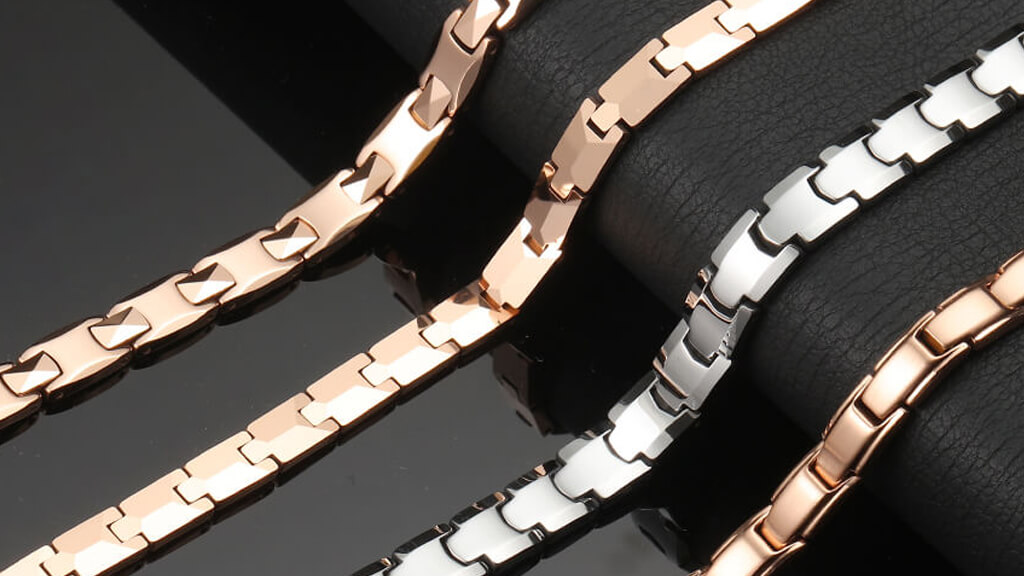
Wood
We all should have an idea of what wood is. It is a fibrous, porous, and organic tissue that is found in the roots and stems of trees and plants. It is composed of cellulose fibers and a lignin matrix making it strong against tension and capable of resisting compression. Hence, it can produce durable and long-lasting products.
Nowadays, wood has become a popular material for jewelry making. It is flexible, and durable and can produce a variety of affordable styles. Two pieces of jewelry that use wood are earrings and bracelets.
Wooden Jewelry Pros and Cons
| Pros | Cons |
| Environmentally Friendly: Who doesn’t love the environment? The use of wood reduces the need for non-renewable sources. Wood will also return to the environment after several years. | Vulnerable to scratch: Wood is not the hardest of materials and is prone to scratch, chips, and dents. |
| Affordability: Wood is easily accessible and cheap. You can get a fashionable vintage piece of jewelry for a reasonable price. | Not Water-resistant: Wood may expand and dry out, and eventually break if it is soaked in water. You can get it coated to prevent this. |
| Unlimited Design Possibilities: Wood can be easily carved into any shape you want it to. You are only limited by your imagination. | Resize issues: Wooden jewelry is difficult to resize. So, you must get the correct size from the start. |
| Hypoallergenic: You don’t have to worry about wooden jewelry triggering a flare-up or causing contact dermatitis. All wooden jewelry is non-irritating. |
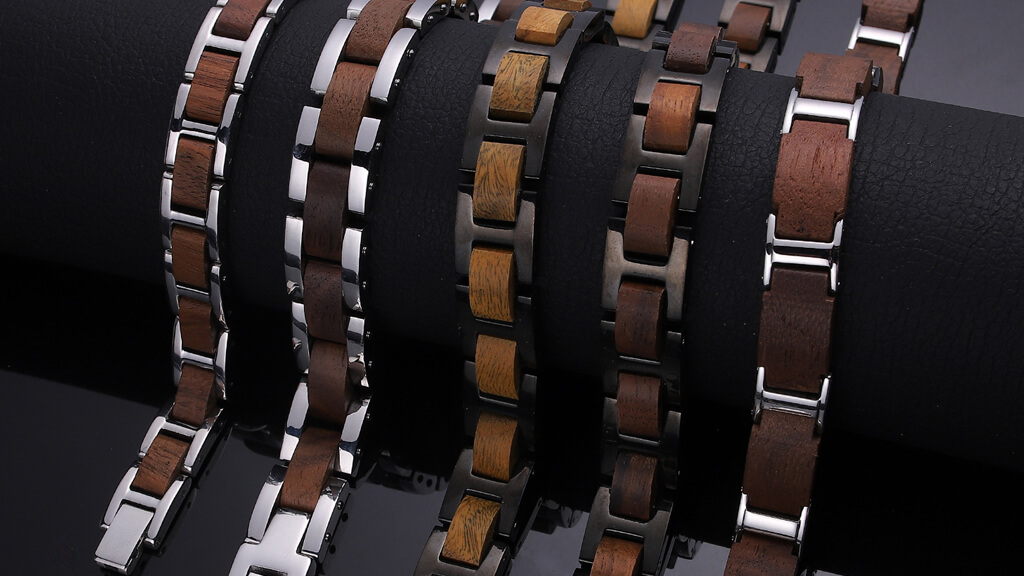
Leather
If you are a leather lover, you will be happy to know that you can get your favorite piece of jewelry in leather. Leather is a material that is strong, durable, and flexible. It is obtained from the chemical treatment or tanning of animal skins and hides. Most leather comes from sheep, cattle, goats, buffalo, equine animals, pigs, alligators, and seals.
Due to the strength and flexibility of the material, leather is used to make several items such as clothing, handbags, footwear, furniture, sports equipment, tools, and even jewelry as of late. These items can last for several decades. China and India are the leading producers of leather.
Leather Jewelry Pros and Cons
| Pros | Cons |
| Durable and Repairable: Leather is strong and long-lasting. It can also be easily repaired if it sustains any damage. | Prone to heart: If it becomes too hot, your leather bracelet can feel sticky on your skin. |
| Affordability: You can get a fashionable vintage piece of leather jewelry for a reasonable price. | Prone to Wear: Leather will wear out eventually. It might come stiff to start with and get relaxed and flexible after a while. |
| Varying Textures: You can get your piece of leather jewelry in different textures. It depends on how you want it to feel. | |
| Variety of colors: You can practically get a piece of leather jewelry in any color of your liking. |
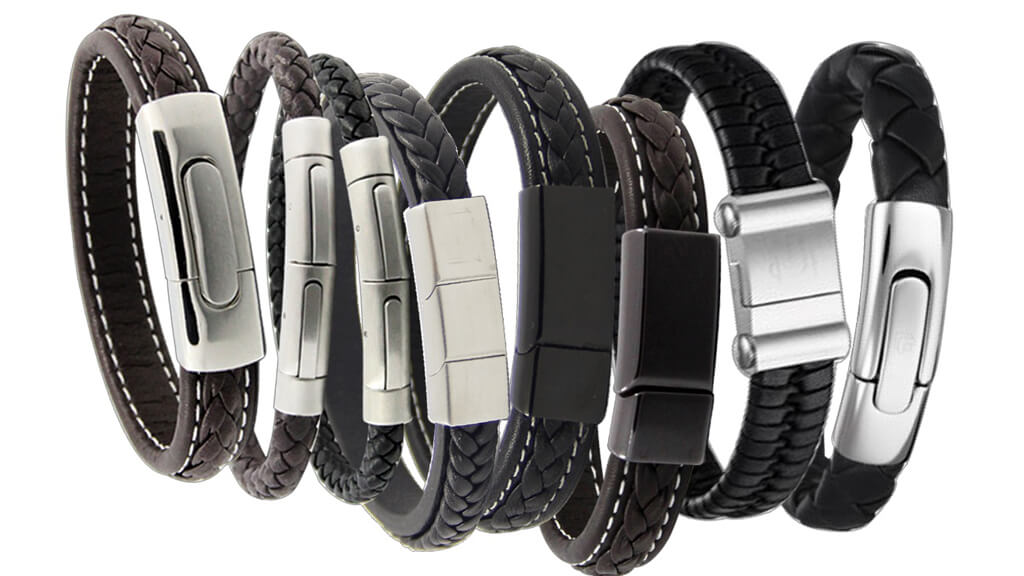
Summary Table
| Properties | Stainless steel | Titanium | Solid Copper | Ceramic | Wood | Tungsten | Leather |
| Hypoallergenic | Yes | Yes | Yes. | Yes | Yes | Yes | Yes |
| Waterproof | Yes | Yes | No | Yes | No | Yes | No |
| Original Color | Silver | Silvery-white | Reddish-brown | White, black, or colored | Creamy white to light brown | Greyish | Russet or Blond |
| Strength | 621 MPa | 241 MPa | 210 MPa | 260-300 MPa | 70 to 140MPa | 980 MPa | 8-25 MPa |
| Ion Plating | Yes | Yes | No | No | No | Yes | No |
| Color Available | rose gold, gold, black, blue, etc | Gold/Rose gold/Black,/Blu | Red | Dyed any color | Painted any color | Grey, silver, black | Painted any color |
| Price | Affordable | A little higher | Affordable | A little higher | A little higher | Much Higher | A little higher |
Final Thoughts
Metals are the most common materials used to make jewelry. Stainless steel, Titanium, Copper, and Tungsten are four such metals. But we have also seen that other materials, organic and inorganic, can be used. These are Ceramic, Wood, and Leather.
Each material has its pros and cons, meaning, it will all come down to individual preference in the end. Which do you prefer? The choice is up to you!


